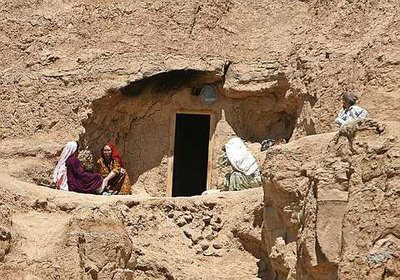By Hadi Ghafari
BAMYAN CITY: During Ramadan, Dowlat Hussain wakes before the sun to perform his morning prayers, but there is nothing to eat for Sahari, he says, as "we live in a cave like animals".

An Afghan family sit outside their cave home in Bamiyan province on April 22, 2009.
Hussain and his family, like hundreds of others too poor to build or rent their own home, live in the honeycomb network of caves that surround the two destroyed Buddha statues in central Bamyan province.
The caves, and there are about 3,000 of them, are thought to have been carved out in the 2nd century to 5th century by Buddhists, before the arrival of Islam. Now they are populated by about 400 families, many who have lived there for a decade, driven out of their own homes by the Taliban.
Each cave is a different size and shape. The smallest is 3 metres long by 2 metres wide while the largest is 15 metres wide by 15 metres long. Some caves are circular, while others are square, rectangular and dome shaped.
Hussain, 48, has been living in a cave with his family for 11 years. All 12 of them, including his son and grandchildren, sleep in one cave which is 8 metres long by 4 metres wide.
"I have a lot of problems in Ramadan. Because the cave is so small when I wake up for Sahari, that causes all the children to wake up," he says.
Hussain's story is common among the cave dwelling families. He says he was a farmer in Karghanato village, but could not support his family.
Unable to afford to build his own house or rent one he moved his family into one of the caves.
Bamyan is a mountainous province, located 200 kilometres from Kabul, and farming land is limited. The major product is the potato, most of which is exported to other provinces. There is little other work as the province does not have any factories or industry.
Dr. Ahsanullah Shaheer, head of Bamyan's Civil Hospital, said due to the lack of fresh air and oxygen in caves, many who live there have skin, bone and respiratory problems.
The children also have difficulties. Their parents cannot afford to send them to school and many have to work to help support the family.
Mohammad Hussain, 57, lives in a cave with his family of seven. The cave is 6 metres length by 3 metres wide and has an Iranian carpet.
At the end of the cave there are boxes and outside is a stone area for cooking.
"We cannot be considered human beings as we live in a cave. We pass our lives in a cave and we live like animals," he says.
Hussain has lived in the cave for the past seven years and says he cannot afford to eat more than once a day or to get medical help for his sick wife.
His children do not go to school and collect firewood or do other odd jobs to support the family.
Hussain's 11-year-old son says that from dusk to dark he collects wood in the mountains but hopes that one day he will be able to go to school like other boys.
Lack of baths is another big problem for the residents of the caves. Children wash in front of the caves, but the adults must go down to the rivers or springs.
For women the situation is even more complicated.
"Here all the women wash their bodies in at night in the open air. Even in winter we have to wash our bodies in the open air," says Amena. The river is more than two kilometres away.
Qurban Ali, 43, fled to the caves after the Taliban burn down his home and killed his relatives in 1997. He now sells things from village to village, but his job cannot support his daily expenses.
Zahra has been living for 12 years in the caves after the Taliban killed her brother, cousin and other male relatives. "So I was forced to escape" she says.
Mohammad Ishaq Poya, head of the provincial department of the Afghan Red Crescent Society, says about 400 families live in the caves, 250 of whom are under the poverty line. Yet he said there has been no assistance from any organization, other than his own.
He says the Red Crescent can provide food to the most vulnerable, but the others also need food and help to build their homes.
He says they have told the Red Crescent headquarters and the Afghanistan National Disaster Management Authority about the problems of those living in caves.
The Bamyan government plans to build homes for the cave residents in other areas of the province, the governor's spokesman, Abdurahman Ahmadi, told Pajhwok Afghan News.
In 2003, 100 cave residents were resettled in homes in the Sangchspan area, their houses built by Shuhada Organisation, one of Afghanistan's oldest non-governmental organisations.
According to a 2009 survey by the Afghanistan Independent Human Right Commission, 75 percent of the cave residents have been there for the 10 years, six percent have been there more than 10 years and 19 percent are new.
The survey also showed that 71 percent had been displaced by the Taliban, food insecurity and poverty.



